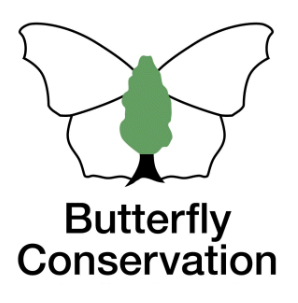Brown Argus
Brown Hairstreak
Chalkhill Blue
Clouded Yellow
Comma
Common Blue
Dark Green Fritillary
Dingy Skipper
Essex Skipper
Gatekeeper
Green Hairstreak
Green-veined White
Grizzled Skipper
Holly Blue
Large Skipper
Large White
Marbled White
Meadow Brown
Orange-tip
Painted Lady
Peacock
Purple Emperor
Purple Hairstreak
Red Admiral
Ringlet
Silver-washed Fritillary
Small Blue
Small Copper
Small Heath
Small Skipper
Small Tortoiseshell
Small White
Speckled Wood
Wall
White Admiral
White-letter Hairstreak
Extinct/rare immigrants
Large White
Pieris brassicae
General Distribution and Status
This species can be seen almost anywhere in the whole of the British Isles. Before the 1950s it was very abundant but the increased use of pesticides on agricultural crops caused significant falls in its numbers. However, it is still very common and a number of immigrants from mainland Europe supplement breeding populations here. According to the UK Butterfly Monitoring Scheme numbers have dropped by about a third since 1976. The situation in Hertfordshire and Middlesex is similar and despite abundance increasing up until around 2015 numbers have fallen significantly since then. Apart from pesticides as noted above, other factors like larval predation and parasitism have a huge effect on Large White populations.
| United Kingdom | Herts & Middx | |||
| Distribution | 1976-2019 | -18% | 1980-2015 | +3% |
| Average 10-year trend | -4% | 2006-2015 | +14% | |
| 2024 since 2015-19 | +8% | |||
| Abundance | 1976-2024 | -34% | 1980-2015 | +33% |
| 2015-2024 | -19% | 2006-2015 | +68% | |
| 2023-2024 | -32% | 2024 since 2015-19 | -31% | |
UK distribution map
UKBMS Species summary
Habitat Requirements
The Large White occurs in almost every habitat type like gardens, allotments, and farmland.
Larval Foodplants
Cabbages Brassica spp.. The brassica noted by Sawford include Brussels Sprout, Kale, Broccoli and Oil-seed Rape. He also mentions Nasturtium Tropaeolum majus and Wild Mignonette Reseda lutea.
Adult Food Sources
Buddleia Buddleja davidii (1074), Lavender Lavandula x intermedia (175), Red Valerian Centranthus ruber (85), Runner Bean Phaseolus coccineus (68), Honesty Lunaria annua (65).
Historical Records
It seems that the Large White has always been very common in Hertfordshire. For instance, Foster in 1934 states it as 'generally abundant'. Some years provide very high populations as in 1959 when reports of third brood specimens were found (Bell) and in 1979 (Waterton).
Local Distribution and Abundance
The Large White is present in every tetrad as indicated on the map. The larger parks in the district namely, Fairlands Valley Park, Knebworth Park and Great Ashby Park, attract the highest populations. Ken King counted 73 specimens on 24 July 2004 in his Knebworth Park transect and I estimated at least 50 at Norton Green on 1 August 2013. 2021 received the highest number of reports during the survey with a total of 264 from which a large majority was submitted to the Big Butterfly Count scheme during the peak of the butterfly's flight season. 2024 was a relatively poor year with far more reports from July onwards but 21 specimens were counted on 11 May near St Paul's Walden.

Stevenage (South Fairlands Valley Park) transect 1993-2025
The heatwave in July 2013 probably contributed to the highest annual count of 131 in that year although a large proportion of these were likely to be migrants. After a poor couple of years in 2016 and 2017 numbers picked up enormously in 2018 aided by the hot and dry weather in June and July, and immigration from the Continent. However, there was not a significant increase in similar weather in 2022. Very few individuals made an appearance (4) in 2023 - the joint worst year but the warm and dry weather in spring and summer 2025 facilitated a large migration from the continent. .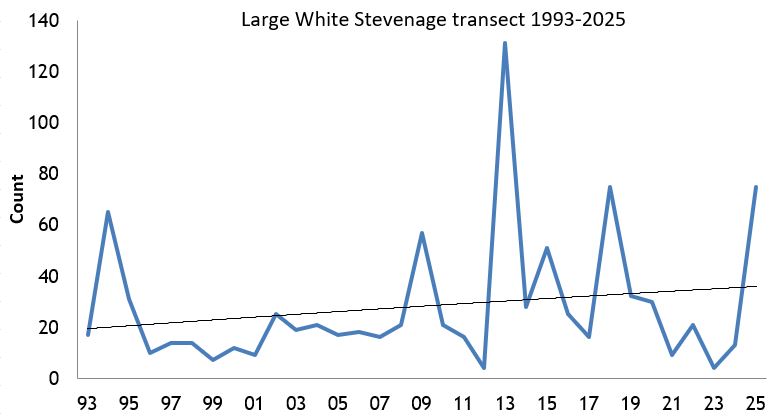
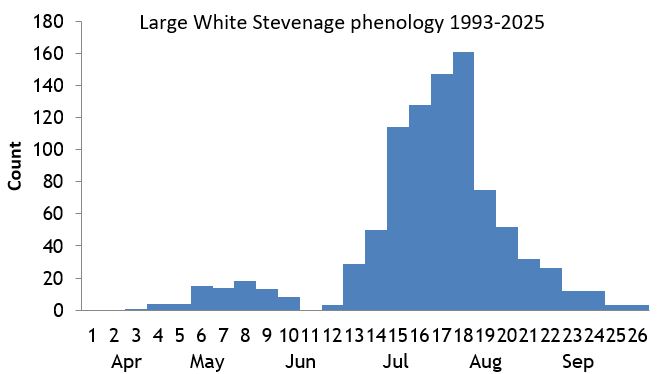
Knebworth Park transect 1996-2010 and 2017-2025
The species showed a slight positive trend in the latter half of the 2000s but with no records between 2011 and 2016 no current trend can be determined. 10 were seen here in 2019 despite some fine weather in the summer like in 2018 when over 100 were recorded. Only five sightings noted in 2024, the lowest annual total on record.
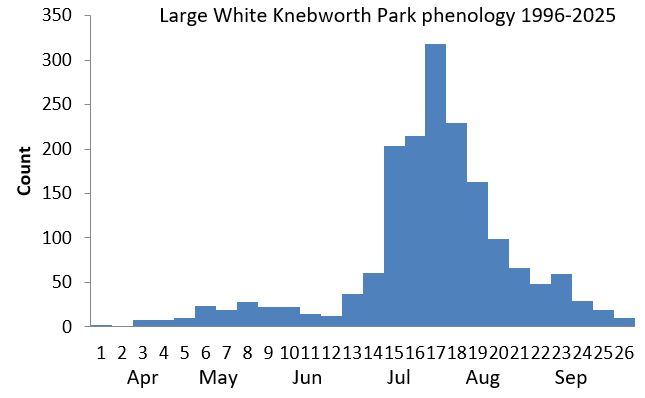
Knebworth Woods transect 2017-2025
A good season in 2018 with about half the specimens found by the footpath between The Firs and Newton Wood. As abundance was also high in the other two transects most specimens were likely to be immigrants. A record number were reported in 2025 here due to the fine weather earlier in the year.
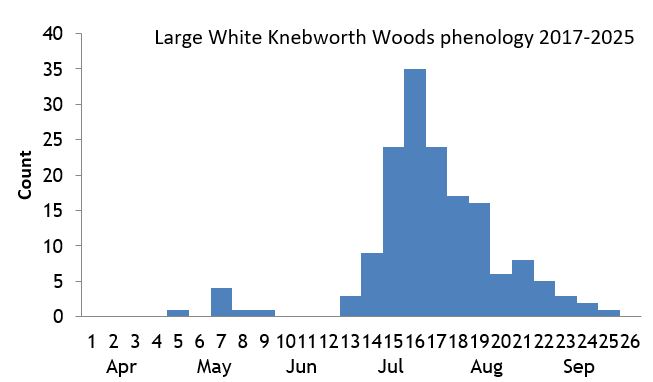
Pryor's Wood transect 2000-2022
Populations of this species have fallen in this decade which does not align what is occurring elsewhere in Hertfordshire. Perhaps a lack of nectar sources or breeding habitat is a cause. 53 individuals were recorded in 2002, the best weekly count being 26 on 26 July.Life History
Earliest date: 1 April 2004 at Knebworth Park
Latest date: 18 October 1997 at Benington Lordship
The Large White overwinters
as a pupa so if there is warm weather in March as in 2004 facilitating speedier development then emergence of the adults should start in early April.
As indicated on the chart, the second brood is usually much larger with a peak in late July. The second generation is augmented by migrants from the Continent.
Any individuals seen in October may be of the third generation especially if warm weather prevails in late summer and September as was the case in 1997.
Large batches of eggs are laid mainly beneath the leaves of Brassica plants. The gregarious larvae can be attacked by the parasitic larvae of the
wasp Apanteles glomeratus which provides some control over the populations of the butterfly. Pupae are usually found on walls and tree trunks.
Behaviour/Observation notes
The Large White is very active so it can be difficult to take close-up pictures of one. In addition, the wings are often closed when feeding on flowers so the best opportunity for taking photographs is very early in the morning when they are often lethargic and their wings are more likely to open (Riley). Usually, the butterfly's size distinguishes it from the other 'whites' but very occasionally, the Large White is on the small side and could be confused with a Small White. The larger and darker tips of the forewings identifies it as a Large White.
Variations/Aberrations
There are many variations and aberrations but are rare apart from minor ones like smaller size.
Find out more on the UK Butterflies website
References

Chapelfoot 9 Jun 2016 (f)

Monks Wood 21 May 2015 (m)

Stevenage 10 Aug 2018

Eggs Stevenage 10 Sep 2018

Larvae Stevenage 1 Oct 2018
